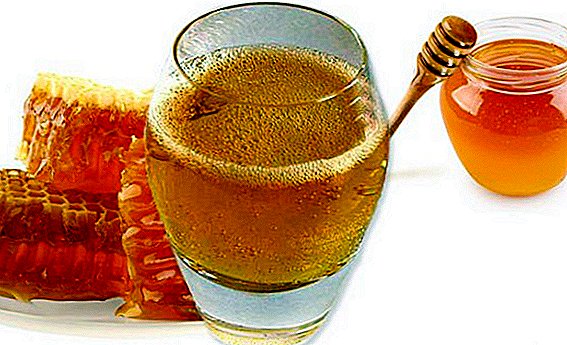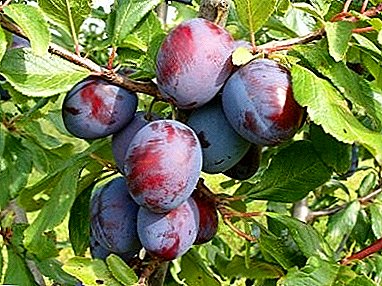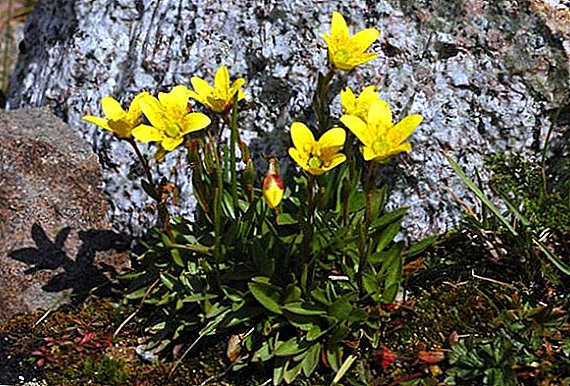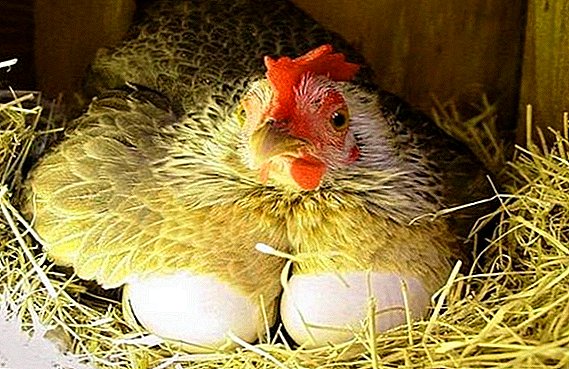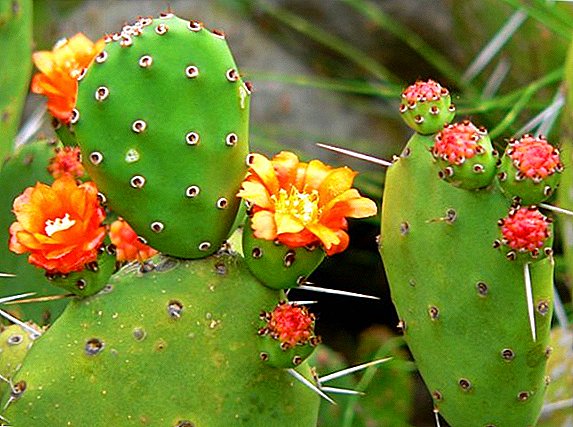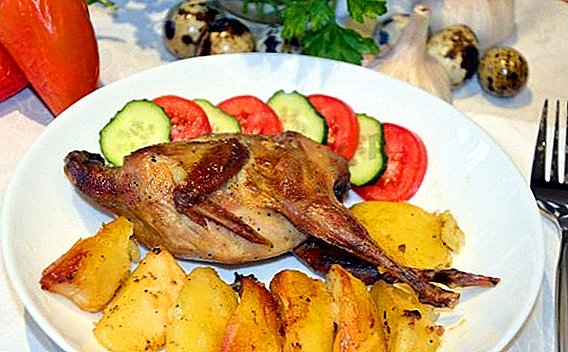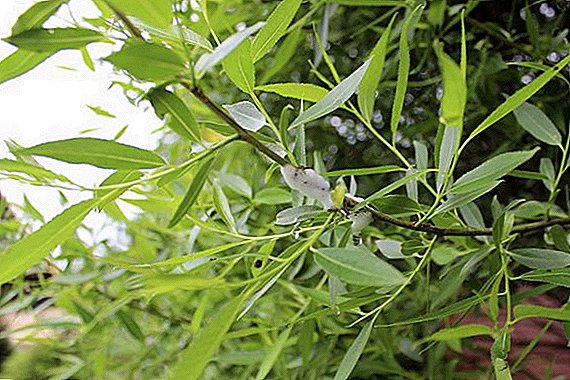 In the wild, there are about 600 species of willows. They come in the form of shrubs and trees, tall and tall, with a variety of leaf shapes and bark color. In culture, there are also many varieties and varieties. And all of them can be threatened by a huge number of diseases and pests. About the most dangerous of them you will learn from this article.
In the wild, there are about 600 species of willows. They come in the form of shrubs and trees, tall and tall, with a variety of leaf shapes and bark color. In culture, there are also many varieties and varieties. And all of them can be threatened by a huge number of diseases and pests. About the most dangerous of them you will learn from this article.
Did you know? Willow rods are widely used in basket weaving, the production of furniture, baskets, so often it is planted not only for decorative purposes, but also for economic purposes.
How to deal with willow diseases
Since basically all pests and pathogens live in the soil, crown and under the fallen leaves of trees, it is necessary to systematically treat the tree trunk. by loosening and deep digging in the autumn, clean dry leaves, follow the recommendations for watering.
In order not to miss the onset of the disease, trees should be periodically inspected. In the fall, at the beginning of leaf fall, willow should be sprayed with 3% Bordeaux liquid. In the spring, during the extension of the kidneys, two treatments are carried out with a 1% solution of copper sulphate with intervals of 4-5 days.
Important! Spraying willow should be carried out in dry, calm weather with the obligatory observance of personal safety measures: the eyes should be protected with glasses, hands with gloves, nose and mouth with a mask.
White heartwood rot
 The causative agent of white core rot trunks serves mushroom false tinder. It provokes decay, first developing in a latent form. Then on the trunks you can see rotten hollows.
The causative agent of white core rot trunks serves mushroom false tinder. It provokes decay, first developing in a latent form. Then on the trunks you can see rotten hollows.
Control measures. The methods of dealing with rot include the following: timely cutting of shrunken, diseased branches and processing of sections; wound healing; filling the hollows, getting rid of the fruit bodies of mushrooms.
Brown Leaf Spot
Willow is affected by several spots: brown, blackish, black, brown. Their development contributes to high humidity. Brown spotting of willow leaves appears in the middle of summer - red-brown spots of irregular shape are formed on the upper parts of the leaves.
Control measures. When the first symptoms of spotting appear, the willow should be treated with fungicides permitted for tree crops. It is necessary to strictly follow the instructions for use.
Black leaf spot
Black leaf spot can progress on all types of willow. At the initial stage of the disease, which usually occurs in July, light spots up to 1.5 cm appear on the sheets. At the end of the summer, black spores appear on their surface. Spores ripen in the spring, then they begin to infect young leaves.
Control measures. Spotted branches must be promptly destroyed by burning. Next, the tree must be two or three times to process chemicals.
Crowned Gaul
 Crown galls are growths on the trunks and roots of willow, which arise as a tree's reaction to irritations caused by pests or fungi. Thus, the plant is trying to protect your body from infection. The tension is quite large, painted in brown. The threat of willow creates, if there is a girdle of the entire trunk. In this case, the plant will be greatly weakened.
Crown galls are growths on the trunks and roots of willow, which arise as a tree's reaction to irritations caused by pests or fungi. Thus, the plant is trying to protect your body from infection. The tension is quite large, painted in brown. The threat of willow creates, if there is a girdle of the entire trunk. In this case, the plant will be greatly weakened.
Control measures. Periodic inspection of trees. Timely fight against harmful insects.
Did you know? Willow is a very strong and resistant tree. It is able to recover even if its trunk is broken almost to the ground.
Mealy dew
Mealy dew has a characteristic symptom - mealy white bloom on the leaves. It manifests itself, as a rule, in July. It is excited by mushrooms. Later, in late July, as the disease progresses, small yellow, brown, and black dots form on the leaves, which contain pathogen spores. They can winter on the fallen leaves, and from the beginning of spring they can infect young leaves with the help of wind and insects. Favorable conditions for the development of powdery mildew on the willow are warm weather and good lighting.
Control measures. Regularly inspect the plant, so as not to miss the signs of the disease at the initial stage. If symptoms are detected, willow is sprayed once or twice with an interval of two weeks with fungicides. Autumn and spring preventive spraying will help protect the tree from powdery mildew.
Willow scab
 Willow scab - a fungal disease, special harm brings to the weeping forms of the plant, although it can infect almost all species. Intensively develops when the wet weather in the fall and spring is long. The first signs appear in spring, two weeks after the beginning of the blooming of young foliage. A characteristic symptom for this disease is blackening of the leaves and shoots of willow. Subsequently, the affected parts of the plant die off. If a willow tree has been infected with a scab for several years in a row, it becomes weak, its immunity is noticeably reduced.
Willow scab - a fungal disease, special harm brings to the weeping forms of the plant, although it can infect almost all species. Intensively develops when the wet weather in the fall and spring is long. The first signs appear in spring, two weeks after the beginning of the blooming of young foliage. A characteristic symptom for this disease is blackening of the leaves and shoots of willow. Subsequently, the affected parts of the plant die off. If a willow tree has been infected with a scab for several years in a row, it becomes weak, its immunity is noticeably reduced.
Control measures. To protect against scab, immediately after leafing, spraying with fungicides is necessary. Re-processing is carried out after 10 days.
Rust
Rust is a fungal disease of willow leaf. Manifested in the summer on the lower part of the sheet plate in the form of rusty spots and spots. With a strong infection, the leaf can be completely covered with a red spot. By the end of summer, numerous yellow-brown dots appear on the top of the leaf plate. Spores spread by wind, winter in fallen leaves. A favorable factor for the development of rust is warm, wet weather.
Did you know? For the development of fungi, the causative agents of rust requires several host plants. Willow is the main host for all pathogens of this disease. Intermediate hosts are currants and larch.Control measures. It is necessary to protect and treat wood from rust using the same methods as with various types of spots. For prevention, dry leaves and affected branches should be burned.
Necrosis of the cortex
 Necrosis of the bark is characteristic of weakened and young plants. Developing in the latter, can lead to their death. The infection is carried through infected branches, from tree to tree. As a result of a long illness, the willow twigs dry out.
Necrosis of the bark is characteristic of weakened and young plants. Developing in the latter, can lead to their death. The infection is carried through infected branches, from tree to tree. As a result of a long illness, the willow twigs dry out.
Control measures. In order not to catch necrosis of the cortex, willow must be healthy. The causative agents of the disease penetrate only into the damaged bark. In a healthy, without cracks, they can not get. Therefore, care must be taken to prevent mechanical damage to the trunk and branches. If they are found, treatment and healing will be required.
Diplodinous necrosis of trunks and branches
Diplodinous necrosis of the trunks and branches most often affects weeping willows. It is excited by a fungus, the spores of which spread with precipitation, wind and insects. The first signs of willow disease appear in April - May. At this stage, the bark on the trunk and branches is colored brown, then dies off and becomes blue-gray. If the disease is not treated, then willow can die in a couple of years. In addition, plants, weakened by necrosis, become easy prey for various kinds of pests that kill the tree.
Control measures. Same as with necrosis.
Tubercular necrosis of branches
 Mushrooms, pathogens of tubercular necrosis affect the branches of weak, sick or pest infected plants. The disease manifests itself in the form of small reddish, brown pads in the thickness of the bark. The bark cracks later, and the sporulation bodies come out.
Mushrooms, pathogens of tubercular necrosis affect the branches of weak, sick or pest infected plants. The disease manifests itself in the form of small reddish, brown pads in the thickness of the bark. The bark cracks later, and the sporulation bodies come out.
Control measures. Prevent weakening of the plant, damage by other diseases and pests. Sick and withered branches, as the main sources of transmission, must be promptly destroyed, the cutoff sites must be disinfected and covered with special means. You also need to start treatment of the plant as soon as possible in case of infection with a fungus or infection.
Cytospor necrosis (cytosporosis) of trunks and branches
Infection with cytosporosis, as a rule, occurs in May - June. Infection affects plants through mechanical damage. This disease leads to the death of the willow bark. Dead spots become brown in color, and later become covered with the bodies of sporulation, dark bumps. In the spring, spores emerge from there and form drops, bundles, spirals of yellow, red, orange color on the trunk and branches. Mature spores are carried by precipitation, wind, and insects. Cytosporosis is able to provoke the death of young plants.
Control measures. In order to prevent cytospore necrosis of the trunks and branches, the same methods of prevention and control are used as with other necrosis.
How to deal with pests of willow
Willows damage about 37 harmful insects. In this article we will only get acquainted with the most dangerous leaves and twigs, which bring significant damage.
Birch Heartfly
Birch core fly harms the rods by making turns. As the rod grows, the strokes tighten, but yellow spots remain in their place, in cross section. At the same time the rod becomes brittle.
Control measures. Due to the fact that the biology of this pest is poorly understood, methods of dealing with it are difficult.
Willow Wolfy
 The willow volnyanka is a white butterfly with a wingspan of 45-55 mm. It is noticeable with black paws with white rings on them. The willowworm caterpillars begin their harmful activities in the spring. During the month they feed on leaves. They pupate in June - July. Two weeks later, butterflies fly out, which make an egg-laying on the trunks, branches, leaves. These caterpillars also skeletonize foliage.
The willow volnyanka is a white butterfly with a wingspan of 45-55 mm. It is noticeable with black paws with white rings on them. The willowworm caterpillars begin their harmful activities in the spring. During the month they feed on leaves. They pupate in June - July. Two weeks later, butterflies fly out, which make an egg-laying on the trunks, branches, leaves. These caterpillars also skeletonize foliage.
Control measures. It is necessary to attract willow plants to control pests of insectivorous birds. In case of mass destruction, i.e., when the caterpillars damage more than 10% of the leaves, it will be necessary to apply insecticides.
Important! The use of chemicals should be resorted to only if for 1 square. m plants observed two or three or more insects.
Alder weevil
The fact that the willow was attacked by an alder weevil is testified by dried leaves on the shoot and numerous passages in the stems. Larvae appear in July - early August. They suffer more from young plants, in which they gnaw bast. Overwinter in bark cracks, in passages in the trunk, in dry leaves. The following year, they begin their harmful activities in the spring: weevils fly out in May to lay eggs and die.
Control measures. The affected rods must be destroyed in the fall after egg-laying or until mid-May.
Willow leaf beetle
 The most dangerous for willow is the second generation of willow-leaf beetles, which comes out in August. Larvae can completely destroy the foliage of the tree. Oviposition is performed in spring on the underside of the leaves. Larvae appear after 7-14 days, begin to feed on the lower leaf plate. Some time later, pupation takes place, and in August a second generation of beetles appears, which skeletonizes both the upper and lower leaf plates. They hibernate under the bark, foliage and in the soil.
The most dangerous for willow is the second generation of willow-leaf beetles, which comes out in August. Larvae can completely destroy the foliage of the tree. Oviposition is performed in spring on the underside of the leaves. Larvae appear after 7-14 days, begin to feed on the lower leaf plate. Some time later, pupation takes place, and in August a second generation of beetles appears, which skeletonizes both the upper and lower leaf plates. They hibernate under the bark, foliage and in the soil.
Did you know? A willow hedge is an excellent wind barrier. Even without leaves, it can reduce wind speed by 60%.Control measures. After cutting the twigs in autumn, the ground between the trees is covered with straw and set on fire together with the old foliage. This will destroy the beetles that went into the soil for the winter. Also during the pupation period, the ground around the willow is flooded with water. During the summer, leaf beetles are caught by special trap traps plastered with tracked glue. In case of mass lesions, intestinal insecticides are used.
Willow leafhopper
The willow tusk is laying eggs to the top of the shoot, after which it cracks, and next year it begins to branch. In early June, the larvae that feed on the juice of shoots appear. As a result, shoots stop growth, become brittle.
 Control measures. The affected branches must be promptly removed. Harvest the larvae by hand, catch the adult snake. Catching is carried out using a canvas, lubricated with tracked glue or tar. It is placed around the tree, and then with a net they pull off the tsikadok from the shoots. They fall and stick to the fabric.
Control measures. The affected branches must be promptly removed. Harvest the larvae by hand, catch the adult snake. Catching is carried out using a canvas, lubricated with tracked glue or tar. It is placed around the tree, and then with a net they pull off the tsikadok from the shoots. They fall and stick to the fabric.
Willowworm
This pest is a butterfly with a wingspan of 44-55 cm. They depart from June to July. They make egg-laying on the bark and leaves. The masonry is like a silvery cake, which is located on the tree throughout the winter. In the spring, black caterpillars with yellow sides and white spots on the back hatch from it. They feed on leaves, and only at night. They pupate at the top of the shoots, entangling them with cobwebs. Such shoots further lose their technical qualities.
The silkworm-moth caterpillars are particularly dangerous for young willows, because they can lead to their death.
Control measures. Nothing, except for preventive and mechanical methods of struggle with the wormworm-moth, has not been invented before this time. In order to prevent the need to attract on willow plantations or in the garden where the tree grows, the natural enemies of this pest - bats, sparrows, insects, equestrians. When insects attack their larvae and eggs are harvested by hand. Butterflies are also caught.
Bag-like bag
 If a willow is damaged by a small bagworm on a tree, there will be a characteristic sign - silky yellow bags 5 cm long hanging from branches. These are peculiar caterpillar shelters. The caterpillars of this moth eat leaves and twigs. As a result, the foliage falls, and the plant weakens.
If a willow is damaged by a small bagworm on a tree, there will be a characteristic sign - silky yellow bags 5 cm long hanging from branches. These are peculiar caterpillar shelters. The caterpillars of this moth eat leaves and twigs. As a result, the foliage falls, and the plant weakens.
Control measures. Treatment with insecticides in the spring, before bud break, and in summer.
Spider mite
Particularly dangerous pests are sucking insects. These include, for example, spider mite. It can be found on the underside of the leaves, where it feeds on the sap of the plant. Soon, the affected willow leaves are deformed, dry out and fall off. The tick survives wintering in the bark, under dry, fallen leaves, in the ground.
Control measures. To fight spider mites is quite difficult. You can apply treatment with soapy water, insecticides. With a strong infection, you will need Karbofos.
Awl willow
Another dangerous sucking insect that affects willow is the common willow aphid. In the spring, it feeds on sap of leaves and shoots. Deformed and twisted leaves, as well as the presence of white scales under the tree - the old shell of the aphid will indicate its presence. Later, when winged aphids appear, they fly over for dill and carrots. These plants produce up to 10 generations of offspring, and in August they return to willow again. Then they lay eggs for the winter in the cracks of the bark.
 Control measures. As you can guess from the description of the life cycle of aphids, in order to avoid its attacks, it is necessary not to plant willow, carrot, dill and parsnip in close proximity. Spraying with decoctions and infusions of insecticidal plants — onion, mustard, henbane, pepper, potato tops, etc. — is also used to repel. The treatment of wood with soap-kerosene mixture and nicotine sulfate is also recommended.
Control measures. As you can guess from the description of the life cycle of aphids, in order to avoid its attacks, it is necessary not to plant willow, carrot, dill and parsnip in close proximity. Spraying with decoctions and infusions of insecticidal plants — onion, mustard, henbane, pepper, potato tops, etc. — is also used to repel. The treatment of wood with soap-kerosene mixture and nicotine sulfate is also recommended.
Rodents
Dangers for willow are mouse-like rodents, which gnaw on roots and cuttings.
Control measures. You can fight rodents with poison baits.
We considered only a small number of diseases and characteristic pests affecting willow. In fact, they are much more. If we follow the rules of agricultural engineering, carry out preventive measures and spraying, then many problems can be avoided. Creating favorable conditions for growth and development of willows will make them much more resistant to ailments and parasites.


